Daniel Sherrier's Blog, page 8
April 25, 2017
Today’s Super Comic — Rising Stars #1 (1999)
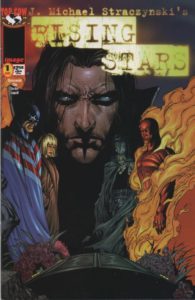 I think Rising Stars was the first time I strayed from my DC/Marvel comfort zone. I lost track of the series before its conclusion, but I remember the early issues were strong.
I think Rising Stars was the first time I strayed from my DC/Marvel comfort zone. I lost track of the series before its conclusion, but I remember the early issues were strong.
The first issue provides an intriguing set-up. A mysterious flash of light affects every child in utero within a certain radius, granting 113 classmates various powers. And later in life, everything will go wrong.
Writer J. Michael Straczynski developed a superhero story that was intended to reach a definitive conclusion. No never-ending battle here. It was going somewhere specific from issue #1. That alone immediately distinguished it from most other comics.
In another nice touch, all super-powered people in this world knew each other from childhood. They have that lifelong connection, which would never work with the Justice League or Avengers. As issue #1 makes clear, these kids would go in all different directions as they grow up, but they share a starting point.
We don’t get a strong sense of the individual characters yet in issue #1, but it’s got me curious enough to want to find out. I can’t vouch for whether the series stuck the landing, but it starts off as an engaging science fiction story. These 113 people are unlike any who came before…now what are they going to do with their lives?
Writer: J. Michael Straczynski
Penciler: Keu Cha
Inker: Jason Gorder
Publisher: Top Cow Productions
How to Read It: back issues; Comixology; included in Rising Stars vol. 1: Born in Fire (TPB)
Appropriate For: ages 15 and up
April 24, 2017
Today’s Super Comic — Daredevil #175 (1981)
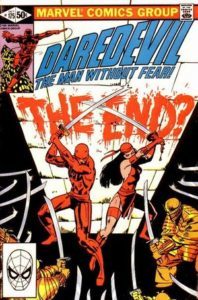 Daredevil #175 opens with what appears to be a spelling error. The title is written as “Gantlet” rather than the more common “Gauntlet,” but according to Grammarist, the former used to be the preferred spelling in certain uses. They’re not perfect synonyms, but there is overlap. If Marvel did accidentally omit the “u,” they got lucky.
Daredevil #175 opens with what appears to be a spelling error. The title is written as “Gantlet” rather than the more common “Gauntlet,” but according to Grammarist, the former used to be the preferred spelling in certain uses. They’re not perfect synonyms, but there is overlap. If Marvel did accidentally omit the “u,” they got lucky.
Elektra faces off against a gauntlet (gantlet?) of Hand ninjas and their master assassin to stop their organization from hunting her. Daredevil backs her up, despite her protests, despite the absence of his radar sense, and despite the fact that he’s supposed to be in court. (He really took Foggy for granted in those days. Poor guy.)
Frank Miller showcases the greatest strengths of his art here. Everything is constantly moving, and the characters are expressive. He balances exceptional choreography and expressive characters throughout the book.
The ambiguous relationship between Daredevil and Elektra provides the substance. On the surface, Elektra is a cold-blooded assassin who’s concerned only about herself. Daredevil can’t help but still care. But maybe Elektra still cares, too? Is the woman he loved still in there somewhere? Or is she as lost as an outdated spelling style?
Ah! Maybe the title isn’t an error, but a symbol! Yeah, that’s it. Sure.
Fantastic issue either way, though.
Writer/Penciler: Frank Miller
Inker: Klaus Janson
Publisher: Marvel Comics
How to Read It: back issues; Marvel Unlimited; Comixology; included in Daredevil Visionaries: Frank Miller vol. 2 (TPB)
Appropriate For: ages 11 and up
April 23, 2017
Today’s Super Comic — Countdown to Infinite Crisis (2005)
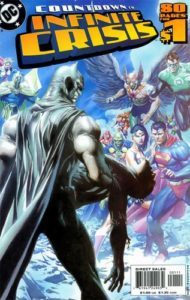 Three people have called themselves the Blue Beetle. The only one I ever followed was the middle guy, Ted Kord. He was in the Justice League when I first started reading comics, but he faded into the background of DC’s ensemble shortly thereafter, occasionally popping up for guest appearances (he showed up in Birds of Prey a bit).
Three people have called themselves the Blue Beetle. The only one I ever followed was the middle guy, Ted Kord. He was in the Justice League when I first started reading comics, but he faded into the background of DC’s ensemble shortly thereafter, occasionally popping up for guest appearances (he showed up in Birds of Prey a bit).
He was just an athletic rich scientist with gadgets, a poor man’s Batman with a personality more like Spider-Man’s. He knew full well he was second-string, if not altogether redundant around other superheroes.
His final story was his best. DC kicked off multiple crossovers with Countdown to Infinite Crisis, a 100-page comic that sold for a dollar (I approve of such marketing techniques).
This prologue functions as a strong story in its own right. Someone’s been messing with Ted’s company, and his investigation leads him to uncover something far bigger. As he pieces this puzzle together, he gradually exhausts the patience of the superhero community, who want to humor the nice guy but have larger problems to deal with. But this second-stringer learns something they’ve all overlooked…and, being a second-stringer, he never gets the chance to tell them.
The Blue Beetle doesn’t die saving the world or any individual person within. But he gets to die with integrity. Given the sincere offer to join a plot against metahumans, and with a gun to his head, Ted declines. No threat to his life will compel him to turn on his friends, no matter how little they think of him sometimes. And he dies as he lived—underestimated.
If you’re going to kill a character to raise the stakes, you have to remember that the character is a character, not cannon fodder. The Blue Beetle’s own agency and motivation lead him to his death, so we care when it happens. It’s not just “The Death of the Blue Beetle!”—it’s a great underdog story.
Writers: Geoff Johns, Greg Rucka, Judd Winick
Artists: Rags Morales, Jesus Saiz, Ivan Reis, Phil Jimenez, Ed Benes
Cover: Jim Lee and Alex Ross
Publisher: DC Comics
How to Read It: back issues; Comixology
Appropriate For: ages 12 and up
April 22, 2017
Today’s Super Comic — Crisis on Infinite Earths #8 (1985)
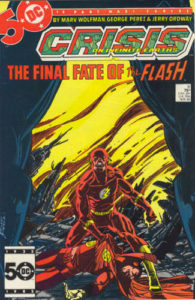 Funny little coincidence: Thirty years before Supergirl and Flash starred in television shows on back-to-back nights, DC killed them off in back-to-back issues of Crisis on Infinite Earths.
Funny little coincidence: Thirty years before Supergirl and Flash starred in television shows on back-to-back nights, DC killed them off in back-to-back issues of Crisis on Infinite Earths.
Okay, maybe not funny. But either way, it’s Barry Allen’s turn to die in issue #8.
This Flash had been around for twenty-nine years at this point, and he had hit a creative low point with a protracted trial storyline that ended his series. So Barry died, sacrificing himself so that the Flash franchise could grow and evolve. Or, in story, sacrificing himself to save the universe.
Flash had been a captive of the Anti-Monitor for most of the miniseries thus far, and the villain’s henchman, the Psycho Pirate, tortured him with emotion-manipulating powers, continuing the trend of this being a low point for the Scarlet Speedster.
But this is the character who kicked off the Silver Age superhero resurgence in 1956, so he deserves one last chance to be amazing—and he gets it. Using his brains as much as his speed, and with only a whimpering lame villain to assist him, he sows confusion among the Anti-Monitor’s minions, allowing him to slip inside the main weapon. After a quick assessment, he knows what he needs to do—and what it will do to him. And he acts anyway. “More than my life is at stake,” he says as he starts running.
He dies running. He dies thinking. He dies alone, without any expectation that anyone would ever learn about his sacrifice.
There’s that old saying that the true test of character is what you do when no one’s looking. When no one was looking, Barry Allen sacrificed his life to save everyone else’s.
Like with Supergirl’s death, Flash’s death stayed true to the character, encapsulating what made him great and giving him a fitting send-off.
Kid Flash, Wally West, would take over, and his series would function as one long coming-of-age story—the former sidekick striving to live up to his hero’s example, this example. Wally’s series, which will always be a sentimental favorite of mine, worked so well that Barry was able to stay dead for longer than twenty years. By comic book standards, that’s a lengthy stint in the afterlife.
Barry hit rock-bottom, caught a last-minute second wind, and went out in top form.
Writer: Marv Wolfman
Penciler: George Perez
Inker: Jerry Ordway
Publisher: DC Comics
How to Read It: back issues; Comixology; included in Crisis on Infinite Earths (TPB)
Appropriate For: ages 10 and up
April 21, 2017
Today’s Super Comic — Crisis on Infinite Earths #7 (1985)
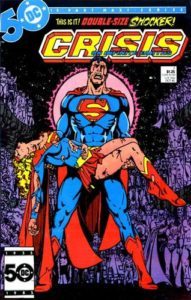 An editorial decree killed Supergirl, but that didn’t stop her from going out in a heroic blaze of glory.
An editorial decree killed Supergirl, but that didn’t stop her from going out in a heroic blaze of glory.
Crisis on Infinite Earths was DC’s first huge crossover series. It pulled together not only every DC character, but also characters inherited from defunct companies such as Fawcett and Charlton. The series’ real-world purpose was to obliterate all these other universes so DC Comics could move forward with a modern, streamlined continuity in a single universe.
And, by the way, Superman needed to be the only surviving Kryptonian in that new continuity. But no one said Supergirl needed to quietly fade away. (Spoilers ahead, of course.)
In Crisis #7, a multi-universal group of powerful superheroes wages a last-ditch campaign against the forces of the even more powerful Anti-Monitor. (“The Anti-Monitor” may not sound like a formidable threat, but he did already destroy all but five universes. I suppose that follows the rule of “show; don’t tell.”) The first part of the issue focuses on lots of cosmic exposition, which I found much more interesting as a kid, but there’s a nice parable within about the danger of excessive pride—it can destroy entire universes! You’ve been warned, kids.
The real heart of the issue is when the focus shifts to Supergirl. It’s unfortunate that she spends the first half in the background, but that’s mega-crossovers for you. When she leaps into action, though, the issue suddenly becomes great.
Naturally, Superman is the first to reach the Anti-Monitor. Everyone expects him to be their best chance of taking down the villain and saving the remaining universes.
But Superman fails. He gets beat, and beat bad.
So Supergirl steps in and steps up. She’s thinking entirely selflessly. She wants to save her only living relative, not only because she cares about him but also because of what he means to the world. Mind you, she’s spent her entire time on Earth living in his shadow, so she’s assuming she could never possibly measure up to his example.
But she does. She clobbers the Anti-Monitor, destroys his machines, saves those universes for the time being…and then she makes a mistake, but for the right reasons. While she’s got the Anti-Monitor on the ropes, she turns away to urge someone else to get to safety, and the Anti-Monitor exploits the moment to fire the fatal shot. She dies exactly as a hero should—putting others first and herself last.
DC would eventually introduce another Supergirl (as I’ve covered before), and then reintroduce a version closer to the original. But in this continuity, this was the definitive ending for this version of the character. This Kara never came back from the dead.
But in her final moments, Supergirl was better than Superman.
Writer: Marv Wolfman
Penciler: George Perez
Inkers: Dick Giordano and Jerry Ordway
Publisher: DC Comics
How to Read It: back issues; Comixology; included in Crisis on Infinite Earths (TPB)
Appropriate For: ages 10 and up
April 20, 2017
Today’s Super Comics — Captain America Reborn #1-6 (2009-10)
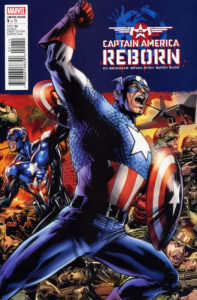 Of course Captain America wasn’t staying dead. We already knew that outcome, but what matters is how they get there. And Captain America Reborn nails it, using Cap’s long history to remind us why he’s such a great character.
Of course Captain America wasn’t staying dead. We already knew that outcome, but what matters is how they get there. And Captain America Reborn nails it, using Cap’s long history to remind us why he’s such a great character.
Steve Rogers has become unstuck in time. He’s being flung back and forth throughout his past, reliving World War II battles, Avengers battles, family moments, his time on ice, etc., and he has to follow the script in every situation. He has some ability to act, but the wrong action could wreck the timestream. It’s quite the elaborate trap.
In the present, Bucky Barnes, Sharon Carter, Falcon, and several Avengers navigate the dual threats of the Red Skull and Norman Osborn (the latter leading a government-sponsored team of villainous Avengers at this point) as they try to save their friend.
This miniseries sustains strong momentum throughout. Ed Brubaker’s script keeps everyone in character at all times, and Bryan Hitch’s art provides a grand sense of scale. It’s all epic without ever losing sight of the individual actors within.
The essence of Captain America is this: He always finds a way, no matter the odds stacked against him. And that’s what we see here.
This isn’t the end of Brubaker’s run on Captain America. However, my year of daily reviews has only twenty-some days left, so this seems like a good stopping point for this particular series. But it’s definitely been worth rereading.
Writer: Ed Brubaker
Penciler: Bryan Hitch
Inker: Butch Guice
Publisher: Marvel Comics
How to Read It: back issues; Marvel Unlimited; Comixology; Captain America Reborn (TPB)
Appropriate For: ages 13 and up
April 19, 2017
Today’s Super Comic — The Uncanny X-Men #319 (1994)
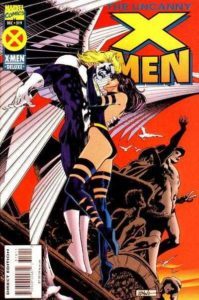 Here’s an excellent example of a mid-‘90s X-Men comic, one of the sort that writer Scott Lobdell excelled at.
Here’s an excellent example of a mid-‘90s X-Men comic, one of the sort that writer Scott Lobdell excelled at.
Uncanny X-Men #319 features three conversations, each featuring a pair of X-characters and each different in nature. And there’s little in the way of comic booky action.
The cover story is Angel (then Archangel) and Psylocke on a date. Meanwhile, Rogue accompanies Iceman on a visit home to his parents, where he clashes with his bigoted father. And on the astral plane, Professor X chats with someone who appears to be Magneto…or is he????
So these three vignettes entail, respectively, a soapy romance, a message of tolerance, and the setup for the next big storyline. All three are essential ingredients to X-Men comics, but each conversation does something a little different than usual.
The budding Angel/Psylocke romance is refreshingly free of drama at this point, just two teammates growing closer in an organic way. Iceman’s father isn’t building any Sentinels. His bigotry is borne of ignorance rather than evil villainy, and as with most bigoted people, it’s not so simple as labeling them wholly “good” or “evil.” Also, Iceman and Rogue had seldom been paired up before this issue, but they had a good enough rapport that the movies later picked up on what started here. And the usual Professor X/Magneto discussion acquires an interesting subtext here once the twist is revealed.
All good stuff.
Writer: Scott Lobdell
Artist: Steve Epting
Inkers: Dan Green and Tim Townsend
Publisher: Marvel Comics
How to Read It: back issues; Marvel Unlimited; Comixology
Appropriate For: ages 11 and up
April 18, 2017
Today’s Super Comic — Green Arrow #11 (2017)
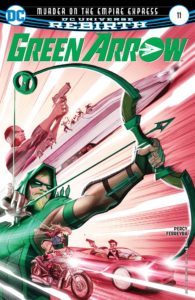 I’m pleased to report that the current Green Arrow series is proving to be consistently fun.
I’m pleased to report that the current Green Arrow series is proving to be consistently fun.
Issue #11 concludes a thriller set on an underwater trans-Pacific railway. Green Arrow, Black Canary, and John Diggle must protect a train full of dignitaries from a mercenary who’s been hired to disrupt upcoming peace talks.
Between Benjamin Percy’s fast-paced script and Juan Ferreyra’s kinetic art, the story is in constant motion. The action is well-staged, the characters are likable, and though the situation is treated as serious, the book never takes itself too seriously—an important balance to strike.
It’s not breaking any molds, but it’s solid, straightforward super-heroics full of great action set pieces.
Writer: Benjamin Percy
Artist: Juan Ferreyra
Publisher: DC Comics
How to Read It: recent back issues; Comixology; included in Green Arrow vol. 2: Island of Scars (TPB)
Appropriate For: ages 13 and up
April 17, 2017
Today’s Super Comic — X-Factor #39 (2009)
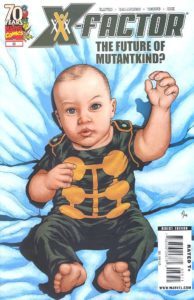 The best plot twists are the ones you didn’t see coming but, in hindsight, they should have been obvious.
The best plot twists are the ones you didn’t see coming but, in hindsight, they should have been obvious.
X-Factor #39 executes exactly that. I don’t want to give this one away—really, if you haven’t already, you need to read Peter David’s phenomenal X-Factor run (both of them, actually). The series that began in 2005, which focuses on Jamie Madrox the Multiple Man leading a terrific ensemble cast, is the greatest X-Men spinoff series I’ve ever read. And I have read many.
I’ll give away the basic setup, though. A while earlier, Madrox had a one-night stand with two women at the same time (his power is he duplicates himself, so he can literally be at two places at once). One of those women got pregnant. Issue #39 is the delivery. And in comic books, childbirth is seldom without complications.
David foreshadows the ending superbly, and yet it still blew me away. Absolutely fantastic storytelling.
Writer: Peter David
Penciler: Valentine De Landro
Inker: Craig Yeung
Publisher: Marvel Comics
How to Read It: back issues; Marvel Unlimited; Comixology; included in X-Factor vol. 7: Time and a Half (TPB)
Appropriate For: ages 13 and up
April 16, 2017
Today’s Super Comics — JLA #62-64 (2002)
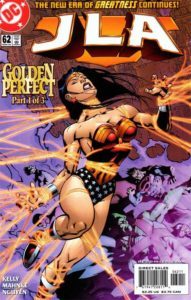 Truth becomes subjective in JLA #62-64, and the results are not good. Well, the story’s good, just not the Earth becoming flat or math not working.
Truth becomes subjective in JLA #62-64, and the results are not good. Well, the story’s good, just not the Earth becoming flat or math not working.
Justice League stories require big, imaginative threats, and this qualifies, and it’s different from the usual fare of super-villains and hostile aliens. The enemy here is the loss of faith in objective reality, which in the DC Universe, naturally, will have sci-fi/fantasy repercussions.
Most important, the danger comes about in a character-based way, as Wonder Woman doubts her magical golden lasso when it offers up competing truths during a delicate situation, one with no tidy answers. Wonder Woman had recently lost her mother, and grief is clouding her judgment.
The issues serve up a worthwhile message: No one has infallible judgment, but truth is truth. We have to respect the truth, or else the moon will turn into cheese and people might die.
The More You Know.
Writer: Joe Kelly
Penciler: Doug Mahnke
Inker: Tom Nguyen
Publisher: DC Comics
How to Read It: back issues; Comixology; included in JLA: Golden Perfect (TPB)
Appropriate For: ages 11 and up



